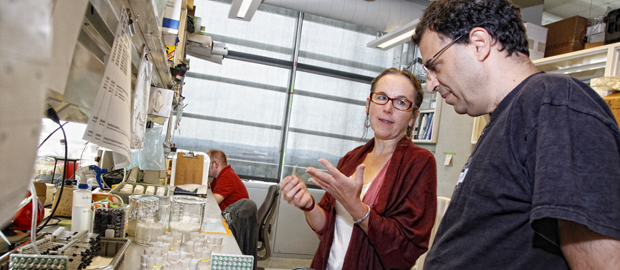Brandeis-Israel Research Initiative starts strong
Neuroscientists find ways to collaborate across the ocean
 Photo/Mike Lovett
Photo/Mike LovettBiology professor Leslie Griffith with Noam Ziv of the Technion Israel Institute of Technology
Despite all the advances in communication technology, nothing beats face-to-face conversations — just ask some Brandeis University neuroscientists who recently spent two days brainstorming with their counterparts from Israel.
“You’d think in the age of email you wouldn’t need to sit down and chat in person about science,” said assistant professor of biology Suzanne Paradis. “But you can be so much more productive in 30 minutes of talking than in 30 emails.”
Paradis is one of several Brandeis faculty developing joint projects with colleagues in Israel as part of the Henry J. Leir Brandeis-Israel Research Initiative, which will underwrite collaborations between Israeli and Brandeis neuroscientists and fund postdoctoral appointments for up-and-coming Israeli scientists at Brandeis.
The $750,000 grant aims to strengthen connections between Brandeis and Israeli scientists and support research projects on the human brain. Four Israeli scientists visited campus last month to meet with faculty and discuss research opportunities.
Eytan Domany, Avraham Yaron and Misha Tsodyks of the Weizmann Institute and Noam Ziv of the Technion Israel Institute of Technology kicked off the two-day session with the new Leir Foundation Neuroscience Symposium, presenting research to faculty, postdoctoral fellows and graduate students. Afterward, they toured labs and met informally with their Brandeis peers.
"It’s good to be able to brainstorm in a relaxed framework, to generate ideas with colleagues,” said Yaron, a faculty member at the Weizmann Institute. “You often find that you share interests."
Yaron and Paradis, for example, are already developing a proposal for a joint research project to study a certain class of molecules that regulate synapse formation called Semaphorins. “Dr. Yaron’s laboratory has expertise in using biochemical approaches to understand how Semaphorins talk to other proteins in the cell, and my lab has expertise in studying these molecules in synapse formation. So it’s a natural fit that we would collaborate to dig deeper into how Semaphorins tell a neuron to build a synapse,” said Paradis.
Ziv, a neuroscientist at the Technion, discovered he and professor of biology Leslie Griffith share a similar interest in understanding sleep.
“I have found that there is someone here doing something very similar to just about everything I do,” said Ziv.
The scientists are forming a committee to evaluate project proposals and postdoctoral applications, and hope to have their first round of funding for projects and fellows by January 2014.
“It was an all-around fabulous meeting, which solidified a long-term relationship with the Leir Foundation and interactions with Israeli scientists,” said Susan Birren, dean of arts and sciences.
Arthur Wingfield, the chair of the neuroscience program at Brandeis, is optimistic about the collaborations despite the distance between the two groups of researchers.
“The neuroscience community is a truly international one,” Wingfield said. “So these collaborations are very natural and very easy.”
Collaborations also foster new ideas — especially across cultures, said Paradis.
“People approach their science differently in different countries so when you collaborate and cross fertilize, you get a whole slew of different ideas that build on so many different experiences,” she said.
Several scientists are already planning follow-up trips, but in the meantime, there is always Skype.
Categories: Research, Science and Technology





